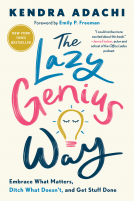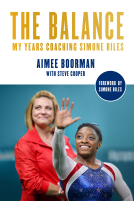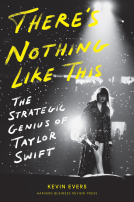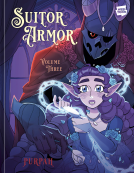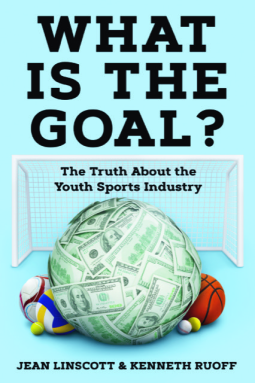
What Is the Goal?
The Truth About the Youth Sports Industry
by Jean Linscott & Kenneth Ruoff
This title was previously available on NetGalley and is now archived.
Send NetGalley books directly to your Kindle or Kindle app
1
To read on a Kindle or Kindle app, please add kindle@netgalley.com as an approved email address to receive files in your Amazon account. Click here for step-by-step instructions.
2
Also find your Kindle email address within your Amazon account, and enter it here.
Pub Date Aug 06 2024 | Archive Date Sep 06 2024
Talking about this book? Use #WhatIstheGoal #NetGalley. More hashtag tips!
Description
Millions of American families spend tens of thousands of dollars annually to have their children participate in club travel sports. In What is the Goal: The Truth About the Youth Sports Industry, the authors educate parents about this industry's money vacuum designed to suck up a family's resources by attaching itself to parents' dreams and fears of missed opportunities for their children's future. The industry is driven largely by the quest for prestige and preferential admission to college. Within the industry, system-wide conflicts of interest cause unintended harm to the young athletes that sports programs should be designed to benefit. Linscott and Ruoff demonstrate how the Youth Sports Industry (YSI) accentuates the wealth and participation gap by pricing out most families.
Young athletes have become valuable commodities to the sports clubs who secure greater earnings in a lucrative industry if they play their business cards right. The authors explore who is making a living off of the YSI and who are its consumers. Linscott and Ruoff analyze the travel tournament, a critical money-generating element of virtually all YSI clubs that accomplishes little in terms of developing athletes. The authors provide a guide for navigating the YSI should parents choose to involve their children. The book also proposes broad, society-wide interconnecting solutions and potential regulations for colleges, medical professionals, legislators, program directors, coaches, and parents to consider. Linscott and Ruoff further the discussion that sports leaders and researchers have initiated to facilitate needed reforms and return the fun and self-empowerment back to the youth athletes.
A Note From the Publisher
Jean Linscott, Ph.D., is a clinical child psychologist. She has been working professionally with children and families for over thirty years in hospital-based, clinic, and private-practice settings. She and Kenneth Ruoff are the parents of three athletes who are veterans of the Youth Sports Industry.
Kenneth Ruoff, Ph.D., is a professor of history at Portland State University and the author of numerous award-winning books. From the perspective of a historian, he is astonished, in comparison to what he experienced as a kid, at how drastically different a youth-sports environment his family has faced these past two decades.
Advance Praise
“The trickle-down influence of commercialization on youth sports during the past generation has morphed into a waterfall. Jean Linscott and Ken Ruoff have experienced this change and used their clinical and historical perspectives to describe how it has impacted the organization and culture of youth sports as well as the experiences of everyone from program managers to child participants and their families. Reading this book provides a foundation for reclaiming youth sports for young people without breaking family budgets.”
—Jay Coakley, Ph.D., Professor Emeritus, Sociology Department, University of Colorado at Colorado Springs
“Through exhaustive research and personal experiences, Ken and Jean have truly captured and exposed the issues within the Youth Sports Industry in America. Having been involved with youth sports (specifically soccer) for over 40 years, I have seen firsthand how the once ‘play for fun’ mentality has shifted due to the enormous pressure that the youth sports environment places on parents, coaches and clubs. This book is spot on in revealing the challenges that face parents when it comes to deciding on which direction to go with their young participating athletes. If you have a son or daughter that is involved in youth sports, reading this book will help you navigate the delicate landscape of the youth sports culture.”
—Dave Sarachan, longtime professional soccer coach and interim coach, United States Men’s National Team, 2017–18
“What Is the Goal? drills deep into the labyrinth of contemporary youth sports and exposes it as a hyper-commercialized mechanism of exploitation that suffocates childhood fun. Ruoff and Linscott combine existing research with a wealth of personal examples to meticulously peel back commercialized youth sports’ many insidious layers. The book also offers thoughtful and positive suggestions for changing both youth sports and the intercollegiate athletic system that often enables it.”
—Rick Eckstein, Ph.D., Author, How College Athletics Are Hurting Girls’ Sports: The Pay to Play Pipeline
Available Editions
| EDITION | Paperback |
| ISBN | 9878990114302 |
| PRICE | $24.99 (USD) |
| PAGES | 212 |
Available on NetGalley
Featured Reviews
 Reviewer 1378100
Reviewer 1378100
I liked this book and found it extremely relatable as someone who has been an athlete her whole life. This was also eye-opening to a lot of things that were going on behind the scenes in youth sports that you weren't aware of as a kid. I feel like this is really important for anyone to read, whether that is as an athlete, parent, or coach, to better grasp this world as a whole.
This book deeply resonated with me and left me shocked. Through story after story of adults behaving badly, it often left me feeling hopeless. Yet, it also made me reflect on how fortunate I am to live in a small Midwestern town where we can mostly avoid the pressures of pay-to-play athletics that have significantly affected kids' ability to simply enjoy themselves. The book really gave voice to my concerns as I watch the trend of increased participation in expensive club sports grow.
Overall, the book was incredibly thought-provoking and tremendously discussable. I do wish it had offered more immediate solutions to improve youth sports in our country, although sadly, I'm not sure there are many feasible ones. Nevertheless, kudos to the authors for their important work. I'd like to thank NetGalley for providing an early copy. I sincerely hope this book finds its audience and sparks meaningful conversations and positive change.
Even if one does not have children who play sports, nearly everyone is aware that there are bad behaving parents at games where youth are the players, and it has put a damper on the enthusiasm of some. Expecting this book to be about that topic, it was eye-opening. While parental behavior is explained, the real wealth a reader will take away from this book is how the Youth Sports Industry (YSI, as abbreviated by the authors liberally) is truly for the well-off, plays off fears of parents and has extraordinary costs for items such as tournaments that should make parents think twice before committing to a pay-to-play league or club.
The main reason for parents wanting to place their athletic children into these programs is the lure of obtaining a college scholarship for athletics, especially at a prestigious university. The programs can be everything from elite traveling teams to tournaments and ID camps when supposedly a coach or coaches from “major” universities will be present to see the athlete in action and can evaluate these athletes. While stopping short of calling these programs fraudulent, the book does a very good job of explaining how the return on investment for these parents – the chances of obtaining that scholarship against the amount spent on this endeavor – is usually not good.
Using their own experience as the parents of three youth soccer players, the authors do a fantastic job of explaining the true motive of these programs – money. While because of their experience, the book is soccer-centric, the authors do explain that their information on the YSI is applicable to any sport in which universities offer scholarships to athletes. Chapters are dedicated to the different aspects of the YSI – coaches, clubs, tournaments, and ID camps are just a few of the aspects covered in the book.
There will be some discussion about the actual games, mainly in tournaments, but that is very limited. The closest to any in-depth discussion about the actual sport (soccer) is in the chapter on coaches and how some of them can be good in developing younger players, such as in the U-12 leagues and how some are looking to win at all costs in order to gain better paying coaching jobs. There will also be some eye-opening accounts that parents should read closely. The best example of this is the true cost of tournaments – these were broken down into the cost per hour of actual playing time for each player and the cost was staggering.
This is just a preview of all the excellent information and advice given to parents who are considering enrolling their young athletes into one of these programs. It is highly recommended for these parents or anyone else interested in the workings of the YSI.
I wish to thank the publisher for providing a review copy of the book. The opinions expressed in this review are strictly my own.
 Arielle G, Reviewer
Arielle G, Reviewer
Thanks to Netgalley and Offside Press for a copy of this book in exchange for an honest review.
I don't have children and don't plan to, but I love sports. I played a variety of sports as a kid, but until now I was never aware of how the Youth Sports Industry (YSI) worked. This book delves into the behind the scenes, especially how the 'pay to play' model negatively affects not just the youth athletes but also the coaches, parents, and general landscape of sport. This book can be impactful for parents looking to put their kids in sport for the right reasons, helping them look for things they may not otherwise have been aware of.
